Business and the Business Environment
VerifiedAdded on 2023/01/18
|14
|4316
|55
AI Summary
This document provides an overview of the different types and purposes of organizations, including public, private, and voluntary sectors. It also discusses the relationship between different organizational functions and how they link to organizational objectives and structure. Additionally, it explores the positive and negative impacts of the macro environment on business operations. The document focuses on TESCO, BBC, and Oxfam as examples.
Contribute Materials
Your contribution can guide someone’s learning journey. Share your
documents today.

Business and the
Business Environment
Business Environment
Secure Best Marks with AI Grader
Need help grading? Try our AI Grader for instant feedback on your assignments.
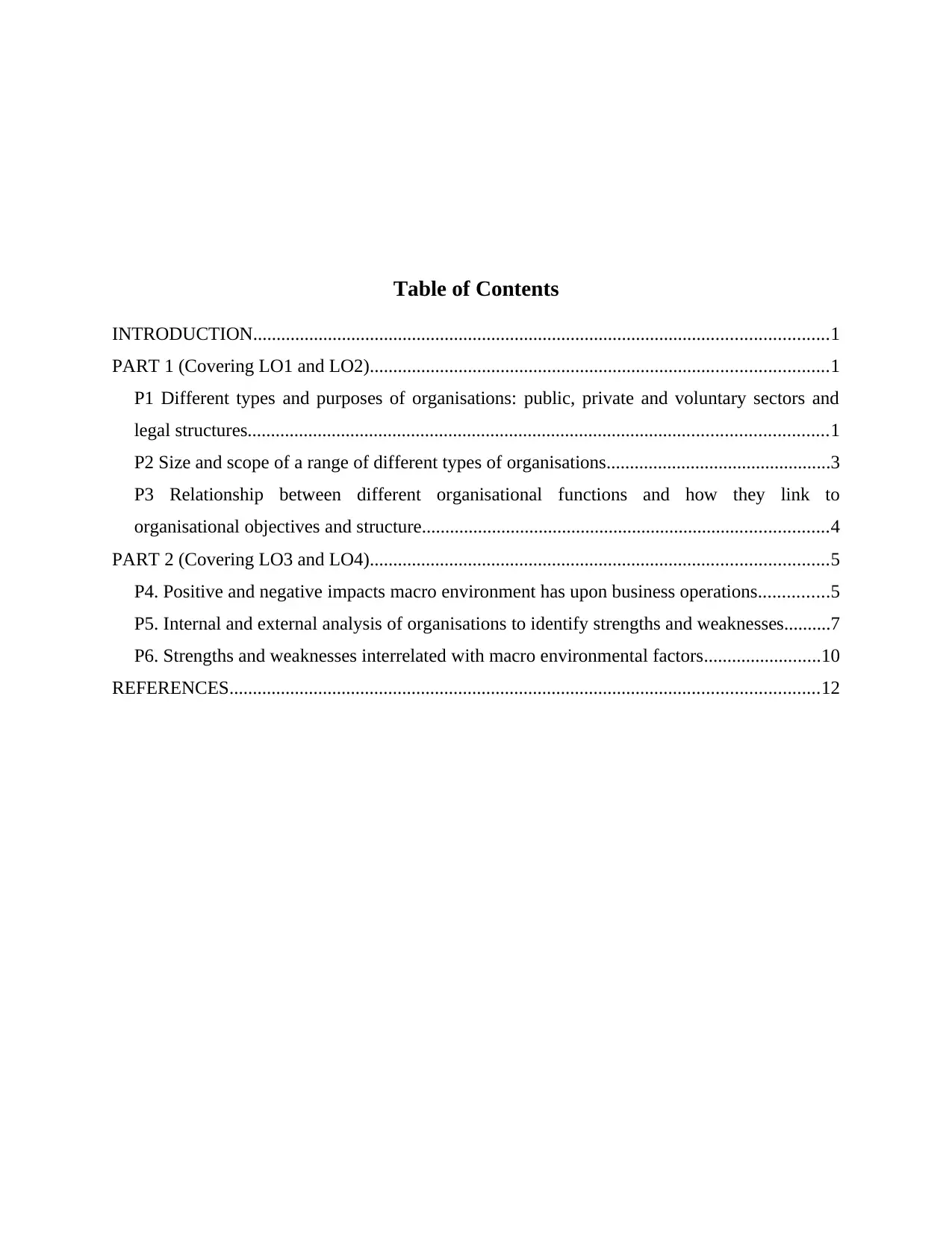
Table of Contents
INTRODUCTION...........................................................................................................................1
PART 1 (Covering LO1 and LO2)..................................................................................................1
P1 Different types and purposes of organisations: public, private and voluntary sectors and
legal structures............................................................................................................................1
P2 Size and scope of a range of different types of organisations................................................3
P3 Relationship between different organisational functions and how they link to
organisational objectives and structure.......................................................................................4
PART 2 (Covering LO3 and LO4)..................................................................................................5
P4. Positive and negative impacts macro environment has upon business operations...............5
P5. Internal and external analysis of organisations to identify strengths and weaknesses..........7
P6. Strengths and weaknesses interrelated with macro environmental factors.........................10
REFERENCES..............................................................................................................................12
INTRODUCTION...........................................................................................................................1
PART 1 (Covering LO1 and LO2)..................................................................................................1
P1 Different types and purposes of organisations: public, private and voluntary sectors and
legal structures............................................................................................................................1
P2 Size and scope of a range of different types of organisations................................................3
P3 Relationship between different organisational functions and how they link to
organisational objectives and structure.......................................................................................4
PART 2 (Covering LO3 and LO4)..................................................................................................5
P4. Positive and negative impacts macro environment has upon business operations...............5
P5. Internal and external analysis of organisations to identify strengths and weaknesses..........7
P6. Strengths and weaknesses interrelated with macro environmental factors.........................10
REFERENCES..............................................................................................................................12
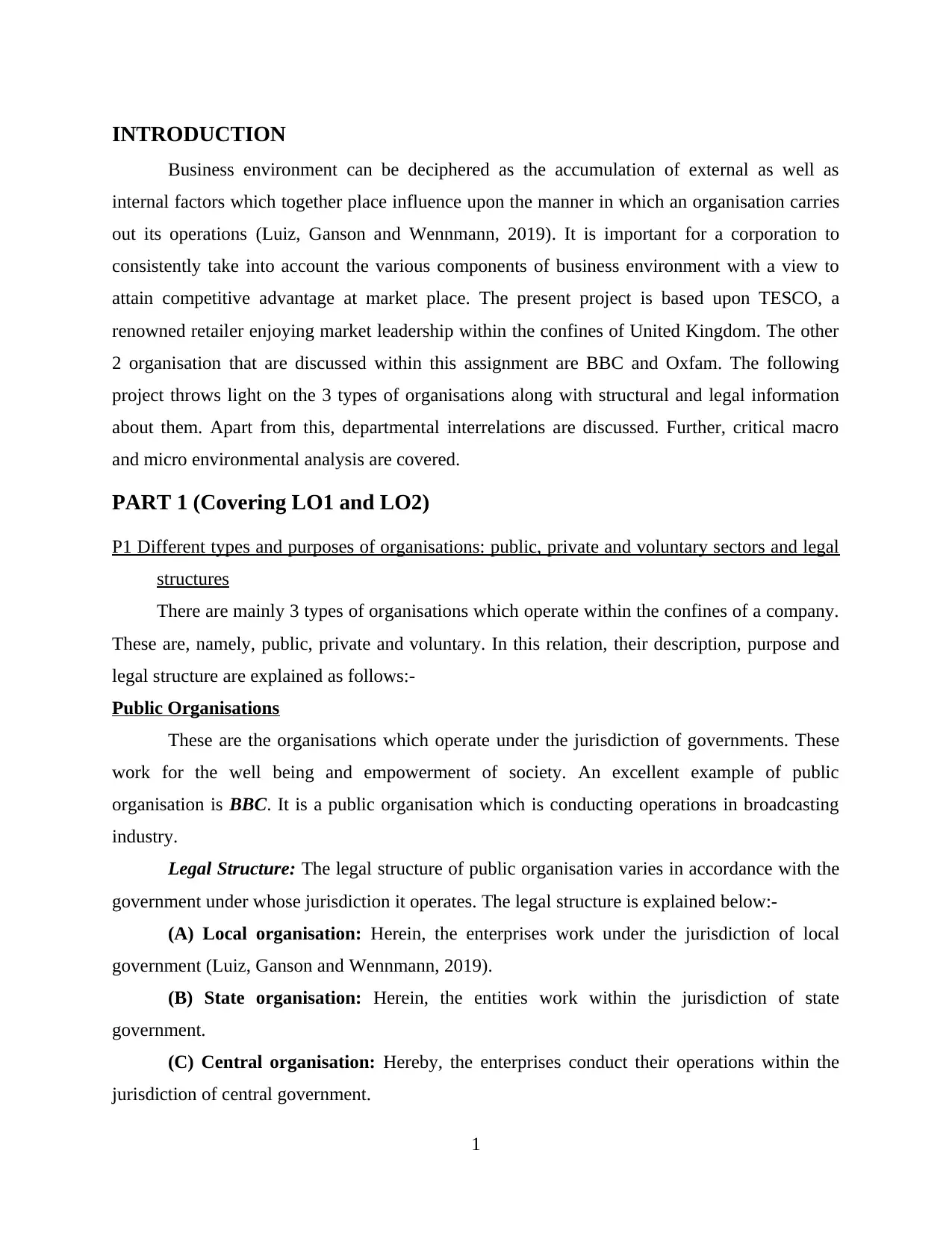
INTRODUCTION
Business environment can be deciphered as the accumulation of external as well as
internal factors which together place influence upon the manner in which an organisation carries
out its operations (Luiz, Ganson and Wennmann, 2019). It is important for a corporation to
consistently take into account the various components of business environment with a view to
attain competitive advantage at market place. The present project is based upon TESCO, a
renowned retailer enjoying market leadership within the confines of United Kingdom. The other
2 organisation that are discussed within this assignment are BBC and Oxfam. The following
project throws light on the 3 types of organisations along with structural and legal information
about them. Apart from this, departmental interrelations are discussed. Further, critical macro
and micro environmental analysis are covered.
PART 1 (Covering LO1 and LO2)
P1 Different types and purposes of organisations: public, private and voluntary sectors and legal
structures
There are mainly 3 types of organisations which operate within the confines of a company.
These are, namely, public, private and voluntary. In this relation, their description, purpose and
legal structure are explained as follows:-
Public Organisations
These are the organisations which operate under the jurisdiction of governments. These
work for the well being and empowerment of society. An excellent example of public
organisation is BBC. It is a public organisation which is conducting operations in broadcasting
industry.
Legal Structure: The legal structure of public organisation varies in accordance with the
government under whose jurisdiction it operates. The legal structure is explained below:-
(A) Local organisation: Herein, the enterprises work under the jurisdiction of local
government (Luiz, Ganson and Wennmann, 2019).
(B) State organisation: Herein, the entities work within the jurisdiction of state
government.
(C) Central organisation: Hereby, the enterprises conduct their operations within the
jurisdiction of central government.
1
Business environment can be deciphered as the accumulation of external as well as
internal factors which together place influence upon the manner in which an organisation carries
out its operations (Luiz, Ganson and Wennmann, 2019). It is important for a corporation to
consistently take into account the various components of business environment with a view to
attain competitive advantage at market place. The present project is based upon TESCO, a
renowned retailer enjoying market leadership within the confines of United Kingdom. The other
2 organisation that are discussed within this assignment are BBC and Oxfam. The following
project throws light on the 3 types of organisations along with structural and legal information
about them. Apart from this, departmental interrelations are discussed. Further, critical macro
and micro environmental analysis are covered.
PART 1 (Covering LO1 and LO2)
P1 Different types and purposes of organisations: public, private and voluntary sectors and legal
structures
There are mainly 3 types of organisations which operate within the confines of a company.
These are, namely, public, private and voluntary. In this relation, their description, purpose and
legal structure are explained as follows:-
Public Organisations
These are the organisations which operate under the jurisdiction of governments. These
work for the well being and empowerment of society. An excellent example of public
organisation is BBC. It is a public organisation which is conducting operations in broadcasting
industry.
Legal Structure: The legal structure of public organisation varies in accordance with the
government under whose jurisdiction it operates. The legal structure is explained below:-
(A) Local organisation: Herein, the enterprises work under the jurisdiction of local
government (Luiz, Ganson and Wennmann, 2019).
(B) State organisation: Herein, the entities work within the jurisdiction of state
government.
(C) Central organisation: Hereby, the enterprises conduct their operations within the
jurisdiction of central government.
1
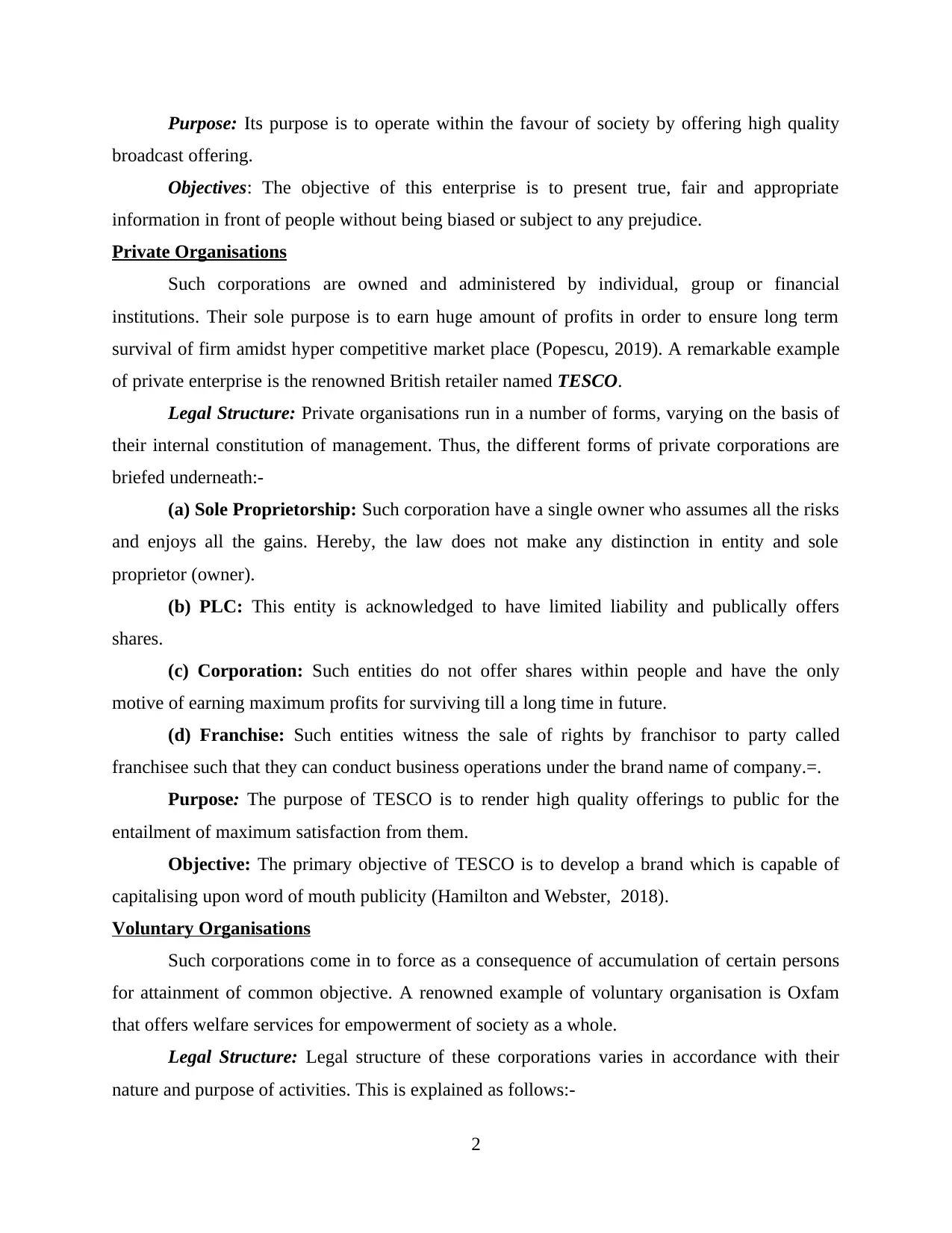
Purpose: Its purpose is to operate within the favour of society by offering high quality
broadcast offering.
Objectives: The objective of this enterprise is to present true, fair and appropriate
information in front of people without being biased or subject to any prejudice.
Private Organisations
Such corporations are owned and administered by individual, group or financial
institutions. Their sole purpose is to earn huge amount of profits in order to ensure long term
survival of firm amidst hyper competitive market place (Popescu, 2019). A remarkable example
of private enterprise is the renowned British retailer named TESCO.
Legal Structure: Private organisations run in a number of forms, varying on the basis of
their internal constitution of management. Thus, the different forms of private corporations are
briefed underneath:-
(a) Sole Proprietorship: Such corporation have a single owner who assumes all the risks
and enjoys all the gains. Hereby, the law does not make any distinction in entity and sole
proprietor (owner).
(b) PLC: This entity is acknowledged to have limited liability and publically offers
shares.
(c) Corporation: Such entities do not offer shares within people and have the only
motive of earning maximum profits for surviving till a long time in future.
(d) Franchise: Such entities witness the sale of rights by franchisor to party called
franchisee such that they can conduct business operations under the brand name of company.=.
Purpose: The purpose of TESCO is to render high quality offerings to public for the
entailment of maximum satisfaction from them.
Objective: The primary objective of TESCO is to develop a brand which is capable of
capitalising upon word of mouth publicity (Hamilton and Webster, 2018).
Voluntary Organisations
Such corporations come in to force as a consequence of accumulation of certain persons
for attainment of common objective. A renowned example of voluntary organisation is Oxfam
that offers welfare services for empowerment of society as a whole.
Legal Structure: Legal structure of these corporations varies in accordance with their
nature and purpose of activities. This is explained as follows:-
2
broadcast offering.
Objectives: The objective of this enterprise is to present true, fair and appropriate
information in front of people without being biased or subject to any prejudice.
Private Organisations
Such corporations are owned and administered by individual, group or financial
institutions. Their sole purpose is to earn huge amount of profits in order to ensure long term
survival of firm amidst hyper competitive market place (Popescu, 2019). A remarkable example
of private enterprise is the renowned British retailer named TESCO.
Legal Structure: Private organisations run in a number of forms, varying on the basis of
their internal constitution of management. Thus, the different forms of private corporations are
briefed underneath:-
(a) Sole Proprietorship: Such corporation have a single owner who assumes all the risks
and enjoys all the gains. Hereby, the law does not make any distinction in entity and sole
proprietor (owner).
(b) PLC: This entity is acknowledged to have limited liability and publically offers
shares.
(c) Corporation: Such entities do not offer shares within people and have the only
motive of earning maximum profits for surviving till a long time in future.
(d) Franchise: Such entities witness the sale of rights by franchisor to party called
franchisee such that they can conduct business operations under the brand name of company.=.
Purpose: The purpose of TESCO is to render high quality offerings to public for the
entailment of maximum satisfaction from them.
Objective: The primary objective of TESCO is to develop a brand which is capable of
capitalising upon word of mouth publicity (Hamilton and Webster, 2018).
Voluntary Organisations
Such corporations come in to force as a consequence of accumulation of certain persons
for attainment of common objective. A renowned example of voluntary organisation is Oxfam
that offers welfare services for empowerment of society as a whole.
Legal Structure: Legal structure of these corporations varies in accordance with their
nature and purpose of activities. This is explained as follows:-
2
Secure Best Marks with AI Grader
Need help grading? Try our AI Grader for instant feedback on your assignments.

(a) NPO: NPOs are institutions that conduct their activities for the purpose of provision
of aid to a single person or a group. They do not function to earn profits.
(b) NGO: These are the entities which conduct their activities independent of
intervention by the government.
Purpose: The purpose of Oxfam is to provide humanitarian services for the elimination
of poverty across the globe.
Objectives: The core objective of this organisation is to empower the society by reducing
the extent of poverty within the world.
P2 Size and scope of a range of different types of organisations
Basis Large - TESCO Medium - Farfetch Small - TFC
Supermarket
About This is a retail corporation
enjoying leadership within
the confines of UK.
This is a luxury retail store
which is engaged in
stipulation of an array of
products via online medium.
This is supermarket that
is engaged in sale of
commodities from
Turkey, Italy, Bulgaria
and some more nations.
Staff Over 452,000 employees
work within TESCO.
It has a staff of 3100
individuals.
This organisation
constitutes approx. 500
individuals whose
collaborative efforts have
made the entity famous.
Size Large Medium Small
Profits Extensive Moderate Low
Scope International – Present in
over 60 nations by way of
its 7,200 outlets.
National – It is conducting its
operations within UK.
Local- 15 outlets within
London
Pricing Cheap priced offerings High priced offerings High priced international
offerings
Classif Tertiary and Secondary Tertiary and Secondary Tertiary and Secondary
3
of aid to a single person or a group. They do not function to earn profits.
(b) NGO: These are the entities which conduct their activities independent of
intervention by the government.
Purpose: The purpose of Oxfam is to provide humanitarian services for the elimination
of poverty across the globe.
Objectives: The core objective of this organisation is to empower the society by reducing
the extent of poverty within the world.
P2 Size and scope of a range of different types of organisations
Basis Large - TESCO Medium - Farfetch Small - TFC
Supermarket
About This is a retail corporation
enjoying leadership within
the confines of UK.
This is a luxury retail store
which is engaged in
stipulation of an array of
products via online medium.
This is supermarket that
is engaged in sale of
commodities from
Turkey, Italy, Bulgaria
and some more nations.
Staff Over 452,000 employees
work within TESCO.
It has a staff of 3100
individuals.
This organisation
constitutes approx. 500
individuals whose
collaborative efforts have
made the entity famous.
Size Large Medium Small
Profits Extensive Moderate Low
Scope International – Present in
over 60 nations by way of
its 7,200 outlets.
National – It is conducting its
operations within UK.
Local- 15 outlets within
London
Pricing Cheap priced offerings High priced offerings High priced international
offerings
Classif Tertiary and Secondary Tertiary and Secondary Tertiary and Secondary
3

ication
Franchising: Franchising allows the other party to deals in the product of franchiser by
using their brand name and earn significant amount of profitability. Usually franchisee pays the
franchiser start up and annual licensing fee in exchanged for gaining.
Joint venture: This is one of the most effective strategies as here the company from
strategic alliance with other company that particularly deals in similar type of industry (Gaganis,
Pasiouras and Voulgari, 2019). This laid the company to effective use the resources in order to
attain the particular objective effectively.
Licensing: Within licensing business arrangement particular company gives authority to
the other company to carry out the manufacture of confined product for which they get special
payment.
P3 Relationship between different organisational functions and how they link to organisational
objectives and structure
There are various functional departments operating within an organisation and all are
work collectively in order to achieve common goals and objectives. Each department is inter
depend on another department and work in coordination with each other. No department can
works solely to attain predetermined goals of company individually. In TESCO, all the
departments are working in coordination and cooperation with each other. This department helps
in accomplish goals of business entity and leads it towards growth and success. The interrelation
between different departments is mentioned below:-
Marketing and Finance: These both the departments are interlinked with each other in
order to carry out operations effectively. For carrying out activities of marketing in a proper
manner, adequate amounts of funds are required which is provided by finance department of
TESCO. Marketing manager communicate with finance department about the funds that are
needed for performing promotional activities (Fabus, 2018). Finance division provides funds to it
in order to ensure that all the advertising and promotional activities are performing in better way.
Effective advertising helps in generating awareness about products and services of TESCO
among customers which in turn increases sales and revenues. This will help finance department
in generating more profits and carry out operations of company effectively. It helps in gaining
competitive advantage in market and attaining large number of market share.
4
Franchising: Franchising allows the other party to deals in the product of franchiser by
using their brand name and earn significant amount of profitability. Usually franchisee pays the
franchiser start up and annual licensing fee in exchanged for gaining.
Joint venture: This is one of the most effective strategies as here the company from
strategic alliance with other company that particularly deals in similar type of industry (Gaganis,
Pasiouras and Voulgari, 2019). This laid the company to effective use the resources in order to
attain the particular objective effectively.
Licensing: Within licensing business arrangement particular company gives authority to
the other company to carry out the manufacture of confined product for which they get special
payment.
P3 Relationship between different organisational functions and how they link to organisational
objectives and structure
There are various functional departments operating within an organisation and all are
work collectively in order to achieve common goals and objectives. Each department is inter
depend on another department and work in coordination with each other. No department can
works solely to attain predetermined goals of company individually. In TESCO, all the
departments are working in coordination and cooperation with each other. This department helps
in accomplish goals of business entity and leads it towards growth and success. The interrelation
between different departments is mentioned below:-
Marketing and Finance: These both the departments are interlinked with each other in
order to carry out operations effectively. For carrying out activities of marketing in a proper
manner, adequate amounts of funds are required which is provided by finance department of
TESCO. Marketing manager communicate with finance department about the funds that are
needed for performing promotional activities (Fabus, 2018). Finance division provides funds to it
in order to ensure that all the advertising and promotional activities are performing in better way.
Effective advertising helps in generating awareness about products and services of TESCO
among customers which in turn increases sales and revenues. This will help finance department
in generating more profits and carry out operations of company effectively. It helps in gaining
competitive advantage in market and attaining large number of market share.
4
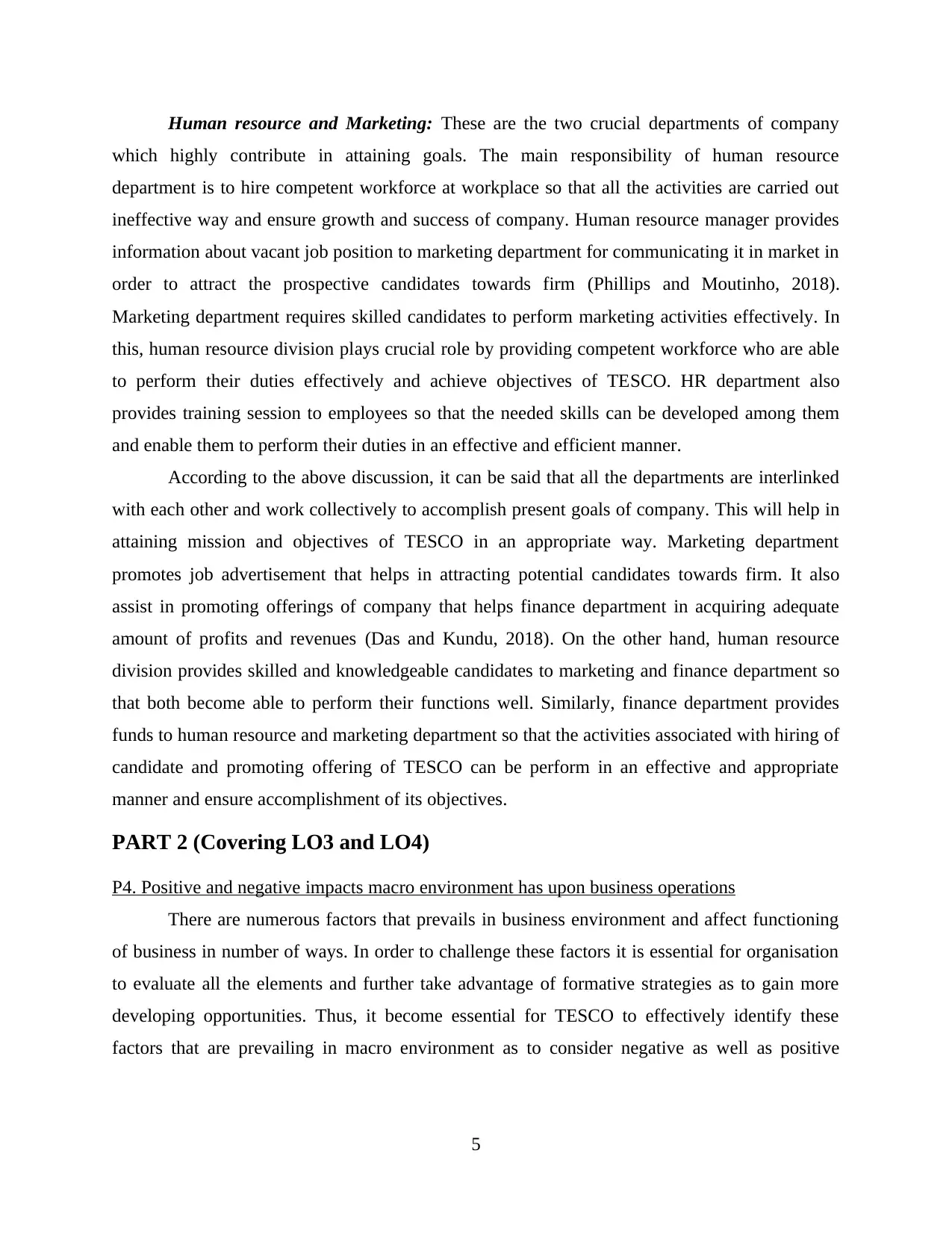
Human resource and Marketing: These are the two crucial departments of company
which highly contribute in attaining goals. The main responsibility of human resource
department is to hire competent workforce at workplace so that all the activities are carried out
ineffective way and ensure growth and success of company. Human resource manager provides
information about vacant job position to marketing department for communicating it in market in
order to attract the prospective candidates towards firm (Phillips and Moutinho, 2018).
Marketing department requires skilled candidates to perform marketing activities effectively. In
this, human resource division plays crucial role by providing competent workforce who are able
to perform their duties effectively and achieve objectives of TESCO. HR department also
provides training session to employees so that the needed skills can be developed among them
and enable them to perform their duties in an effective and efficient manner.
According to the above discussion, it can be said that all the departments are interlinked
with each other and work collectively to accomplish present goals of company. This will help in
attaining mission and objectives of TESCO in an appropriate way. Marketing department
promotes job advertisement that helps in attracting potential candidates towards firm. It also
assist in promoting offerings of company that helps finance department in acquiring adequate
amount of profits and revenues (Das and Kundu, 2018). On the other hand, human resource
division provides skilled and knowledgeable candidates to marketing and finance department so
that both become able to perform their functions well. Similarly, finance department provides
funds to human resource and marketing department so that the activities associated with hiring of
candidate and promoting offering of TESCO can be perform in an effective and appropriate
manner and ensure accomplishment of its objectives.
PART 2 (Covering LO3 and LO4)
P4. Positive and negative impacts macro environment has upon business operations
There are numerous factors that prevails in business environment and affect functioning
of business in number of ways. In order to challenge these factors it is essential for organisation
to evaluate all the elements and further take advantage of formative strategies as to gain more
developing opportunities. Thus, it become essential for TESCO to effectively identify these
factors that are prevailing in macro environment as to consider negative as well as positive
5
which highly contribute in attaining goals. The main responsibility of human resource
department is to hire competent workforce at workplace so that all the activities are carried out
ineffective way and ensure growth and success of company. Human resource manager provides
information about vacant job position to marketing department for communicating it in market in
order to attract the prospective candidates towards firm (Phillips and Moutinho, 2018).
Marketing department requires skilled candidates to perform marketing activities effectively. In
this, human resource division plays crucial role by providing competent workforce who are able
to perform their duties effectively and achieve objectives of TESCO. HR department also
provides training session to employees so that the needed skills can be developed among them
and enable them to perform their duties in an effective and efficient manner.
According to the above discussion, it can be said that all the departments are interlinked
with each other and work collectively to accomplish present goals of company. This will help in
attaining mission and objectives of TESCO in an appropriate way. Marketing department
promotes job advertisement that helps in attracting potential candidates towards firm. It also
assist in promoting offerings of company that helps finance department in acquiring adequate
amount of profits and revenues (Das and Kundu, 2018). On the other hand, human resource
division provides skilled and knowledgeable candidates to marketing and finance department so
that both become able to perform their functions well. Similarly, finance department provides
funds to human resource and marketing department so that the activities associated with hiring of
candidate and promoting offering of TESCO can be perform in an effective and appropriate
manner and ensure accomplishment of its objectives.
PART 2 (Covering LO3 and LO4)
P4. Positive and negative impacts macro environment has upon business operations
There are numerous factors that prevails in business environment and affect functioning
of business in number of ways. In order to challenge these factors it is essential for organisation
to evaluate all the elements and further take advantage of formative strategies as to gain more
developing opportunities. Thus, it become essential for TESCO to effectively identify these
factors that are prevailing in macro environment as to consider negative as well as positive
5
Paraphrase This Document
Need a fresh take? Get an instant paraphrase of this document with our AI Paraphraser
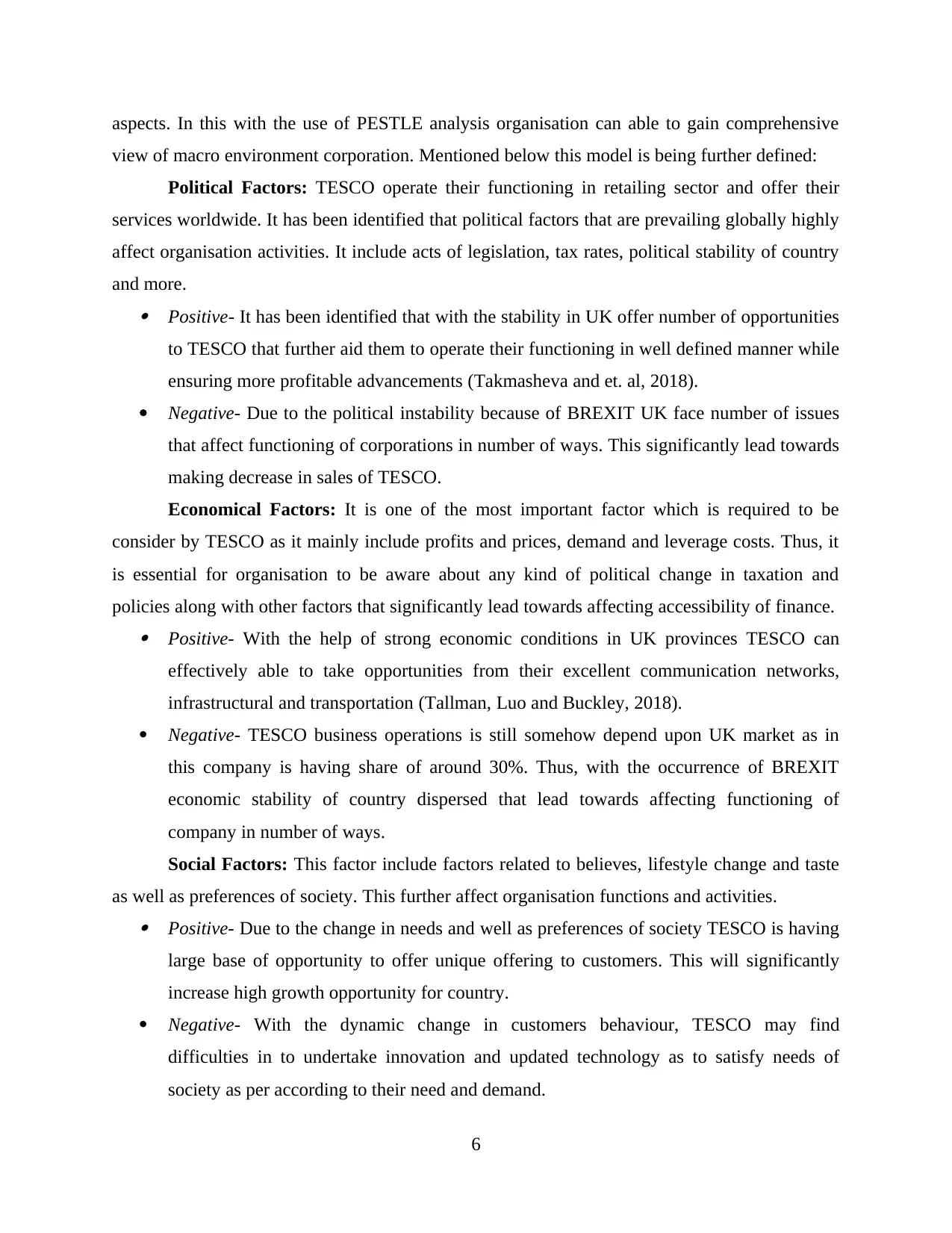
aspects. In this with the use of PESTLE analysis organisation can able to gain comprehensive
view of macro environment corporation. Mentioned below this model is being further defined:
Political Factors: TESCO operate their functioning in retailing sector and offer their
services worldwide. It has been identified that political factors that are prevailing globally highly
affect organisation activities. It include acts of legislation, tax rates, political stability of country
and more. Positive- It has been identified that with the stability in UK offer number of opportunities
to TESCO that further aid them to operate their functioning in well defined manner while
ensuring more profitable advancements (Takmashеva and et. al, 2018).
Negative- Due to the political instability because of BREXIT UK face number of issues
that affect functioning of corporations in number of ways. This significantly lead towards
making decrease in sales of TESCO.
Economical Factors: It is one of the most important factor which is required to be
consider by TESCO as it mainly include profits and prices, demand and leverage costs. Thus, it
is essential for organisation to be aware about any kind of political change in taxation and
policies along with other factors that significantly lead towards affecting accessibility of finance. Positive- With the help of strong economic conditions in UK provinces TESCO can
effectively able to take opportunities from their excellent communication networks,
infrastructural and transportation (Tallman, Luo and Buckley, 2018).
Negative- TESCO business operations is still somehow depend upon UK market as in
this company is having share of around 30%. Thus, with the occurrence of BREXIT
economic stability of country dispersed that lead towards affecting functioning of
company in number of ways.
Social Factors: This factor include factors related to believes, lifestyle change and taste
as well as preferences of society. This further affect organisation functions and activities. Positive- Due to the change in needs and well as preferences of society TESCO is having
large base of opportunity to offer unique offering to customers. This will significantly
increase high growth opportunity for country.
Negative- With the dynamic change in customers behaviour, TESCO may find
difficulties in to undertake innovation and updated technology as to satisfy needs of
society as per according to their need and demand.
6
view of macro environment corporation. Mentioned below this model is being further defined:
Political Factors: TESCO operate their functioning in retailing sector and offer their
services worldwide. It has been identified that political factors that are prevailing globally highly
affect organisation activities. It include acts of legislation, tax rates, political stability of country
and more. Positive- It has been identified that with the stability in UK offer number of opportunities
to TESCO that further aid them to operate their functioning in well defined manner while
ensuring more profitable advancements (Takmashеva and et. al, 2018).
Negative- Due to the political instability because of BREXIT UK face number of issues
that affect functioning of corporations in number of ways. This significantly lead towards
making decrease in sales of TESCO.
Economical Factors: It is one of the most important factor which is required to be
consider by TESCO as it mainly include profits and prices, demand and leverage costs. Thus, it
is essential for organisation to be aware about any kind of political change in taxation and
policies along with other factors that significantly lead towards affecting accessibility of finance. Positive- With the help of strong economic conditions in UK provinces TESCO can
effectively able to take opportunities from their excellent communication networks,
infrastructural and transportation (Tallman, Luo and Buckley, 2018).
Negative- TESCO business operations is still somehow depend upon UK market as in
this company is having share of around 30%. Thus, with the occurrence of BREXIT
economic stability of country dispersed that lead towards affecting functioning of
company in number of ways.
Social Factors: This factor include factors related to believes, lifestyle change and taste
as well as preferences of society. This further affect organisation functions and activities. Positive- Due to the change in needs and well as preferences of society TESCO is having
large base of opportunity to offer unique offering to customers. This will significantly
increase high growth opportunity for country.
Negative- With the dynamic change in customers behaviour, TESCO may find
difficulties in to undertake innovation and updated technology as to satisfy needs of
society as per according to their need and demand.
6
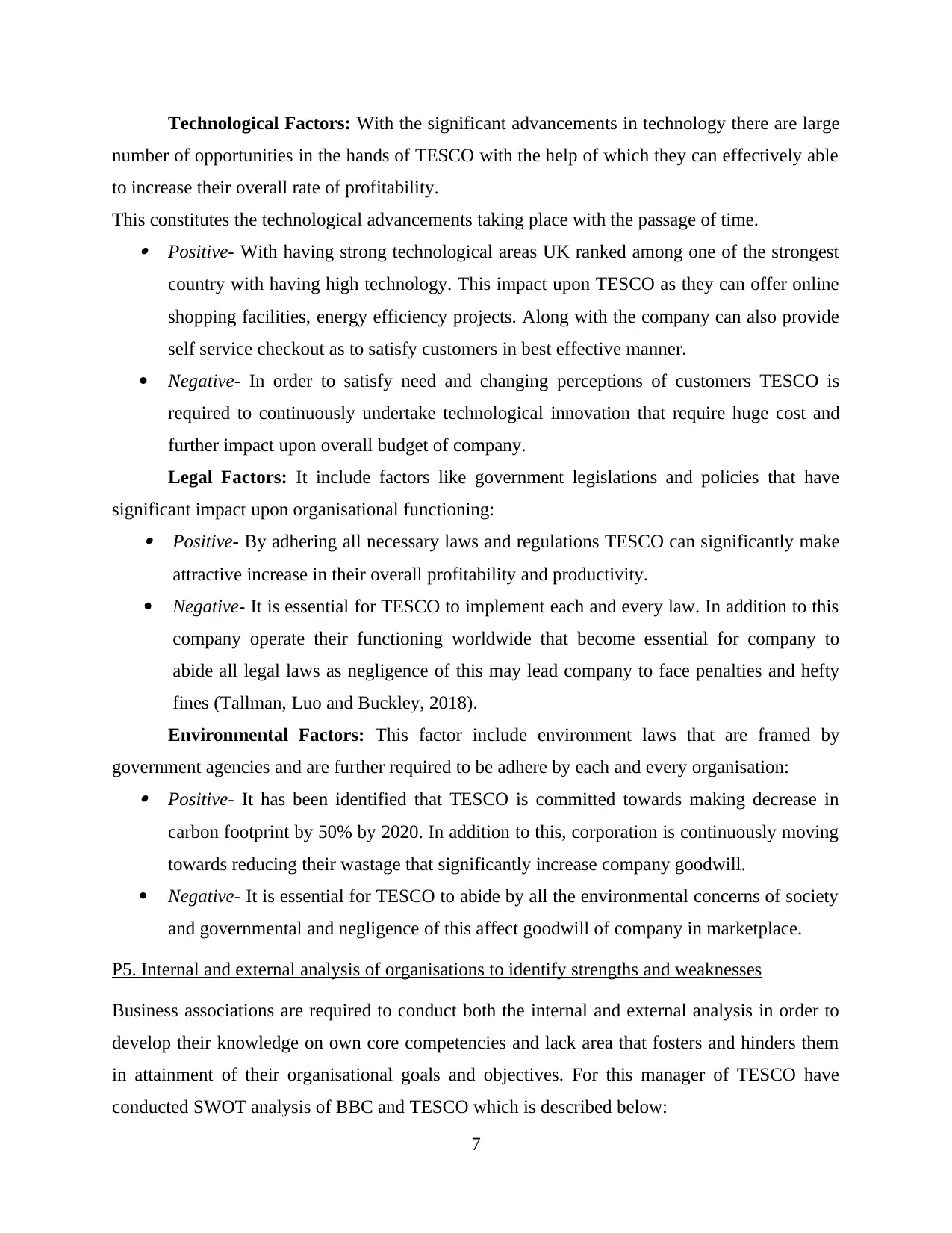
Technological Factors: With the significant advancements in technology there are large
number of opportunities in the hands of TESCO with the help of which they can effectively able
to increase their overall rate of profitability.
This constitutes the technological advancements taking place with the passage of time. Positive- With having strong technological areas UK ranked among one of the strongest
country with having high technology. This impact upon TESCO as they can offer online
shopping facilities, energy efficiency projects. Along with the company can also provide
self service checkout as to satisfy customers in best effective manner.
Negative- In order to satisfy need and changing perceptions of customers TESCO is
required to continuously undertake technological innovation that require huge cost and
further impact upon overall budget of company.
Legal Factors: It include factors like government legislations and policies that have
significant impact upon organisational functioning: Positive- By adhering all necessary laws and regulations TESCO can significantly make
attractive increase in their overall profitability and productivity.
Negative- It is essential for TESCO to implement each and every law. In addition to this
company operate their functioning worldwide that become essential for company to
abide all legal laws as negligence of this may lead company to face penalties and hefty
fines (Tallman, Luo and Buckley, 2018).
Environmental Factors: This factor include environment laws that are framed by
government agencies and are further required to be adhere by each and every organisation: Positive- It has been identified that TESCO is committed towards making decrease in
carbon footprint by 50% by 2020. In addition to this, corporation is continuously moving
towards reducing their wastage that significantly increase company goodwill.
Negative- It is essential for TESCO to abide by all the environmental concerns of society
and governmental and negligence of this affect goodwill of company in marketplace.
P5. Internal and external analysis of organisations to identify strengths and weaknesses
Business associations are required to conduct both the internal and external analysis in order to
develop their knowledge on own core competencies and lack area that fosters and hinders them
in attainment of their organisational goals and objectives. For this manager of TESCO have
conducted SWOT analysis of BBC and TESCO which is described below:
7
number of opportunities in the hands of TESCO with the help of which they can effectively able
to increase their overall rate of profitability.
This constitutes the technological advancements taking place with the passage of time. Positive- With having strong technological areas UK ranked among one of the strongest
country with having high technology. This impact upon TESCO as they can offer online
shopping facilities, energy efficiency projects. Along with the company can also provide
self service checkout as to satisfy customers in best effective manner.
Negative- In order to satisfy need and changing perceptions of customers TESCO is
required to continuously undertake technological innovation that require huge cost and
further impact upon overall budget of company.
Legal Factors: It include factors like government legislations and policies that have
significant impact upon organisational functioning: Positive- By adhering all necessary laws and regulations TESCO can significantly make
attractive increase in their overall profitability and productivity.
Negative- It is essential for TESCO to implement each and every law. In addition to this
company operate their functioning worldwide that become essential for company to
abide all legal laws as negligence of this may lead company to face penalties and hefty
fines (Tallman, Luo and Buckley, 2018).
Environmental Factors: This factor include environment laws that are framed by
government agencies and are further required to be adhere by each and every organisation: Positive- It has been identified that TESCO is committed towards making decrease in
carbon footprint by 50% by 2020. In addition to this, corporation is continuously moving
towards reducing their wastage that significantly increase company goodwill.
Negative- It is essential for TESCO to abide by all the environmental concerns of society
and governmental and negligence of this affect goodwill of company in marketplace.
P5. Internal and external analysis of organisations to identify strengths and weaknesses
Business associations are required to conduct both the internal and external analysis in order to
develop their knowledge on own core competencies and lack area that fosters and hinders them
in attainment of their organisational goals and objectives. For this manager of TESCO have
conducted SWOT analysis of BBC and TESCO which is described below:
7
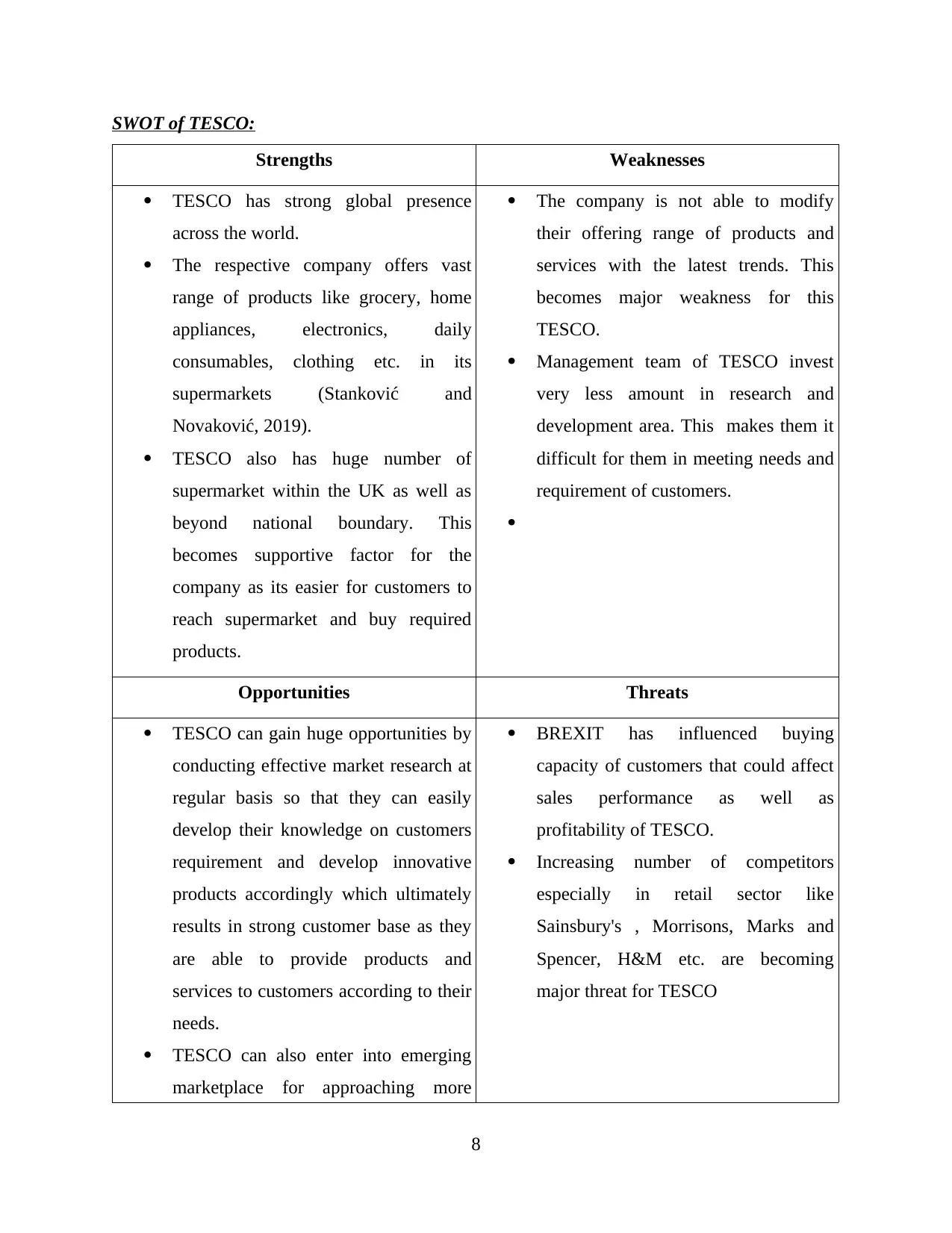
SWOT of TESCO:
Strengths Weaknesses
TESCO has strong global presence
across the world.
The respective company offers vast
range of products like grocery, home
appliances, electronics, daily
consumables, clothing etc. in its
supermarkets (Stanković and
Novaković, 2019).
TESCO also has huge number of
supermarket within the UK as well as
beyond national boundary. This
becomes supportive factor for the
company as its easier for customers to
reach supermarket and buy required
products.
The company is not able to modify
their offering range of products and
services with the latest trends. This
becomes major weakness for this
TESCO.
Management team of TESCO invest
very less amount in research and
development area. This makes them it
difficult for them in meeting needs and
requirement of customers.
Opportunities Threats
TESCO can gain huge opportunities by
conducting effective market research at
regular basis so that they can easily
develop their knowledge on customers
requirement and develop innovative
products accordingly which ultimately
results in strong customer base as they
are able to provide products and
services to customers according to their
needs.
TESCO can also enter into emerging
marketplace for approaching more
BREXIT has influenced buying
capacity of customers that could affect
sales performance as well as
profitability of TESCO.
Increasing number of competitors
especially in retail sector like
Sainsbury's , Morrisons, Marks and
Spencer, H&M etc. are becoming
major threat for TESCO
8
Strengths Weaknesses
TESCO has strong global presence
across the world.
The respective company offers vast
range of products like grocery, home
appliances, electronics, daily
consumables, clothing etc. in its
supermarkets (Stanković and
Novaković, 2019).
TESCO also has huge number of
supermarket within the UK as well as
beyond national boundary. This
becomes supportive factor for the
company as its easier for customers to
reach supermarket and buy required
products.
The company is not able to modify
their offering range of products and
services with the latest trends. This
becomes major weakness for this
TESCO.
Management team of TESCO invest
very less amount in research and
development area. This makes them it
difficult for them in meeting needs and
requirement of customers.
Opportunities Threats
TESCO can gain huge opportunities by
conducting effective market research at
regular basis so that they can easily
develop their knowledge on customers
requirement and develop innovative
products accordingly which ultimately
results in strong customer base as they
are able to provide products and
services to customers according to their
needs.
TESCO can also enter into emerging
marketplace for approaching more
BREXIT has influenced buying
capacity of customers that could affect
sales performance as well as
profitability of TESCO.
Increasing number of competitors
especially in retail sector like
Sainsbury's , Morrisons, Marks and
Spencer, H&M etc. are becoming
major threat for TESCO
8
Secure Best Marks with AI Grader
Need help grading? Try our AI Grader for instant feedback on your assignments.
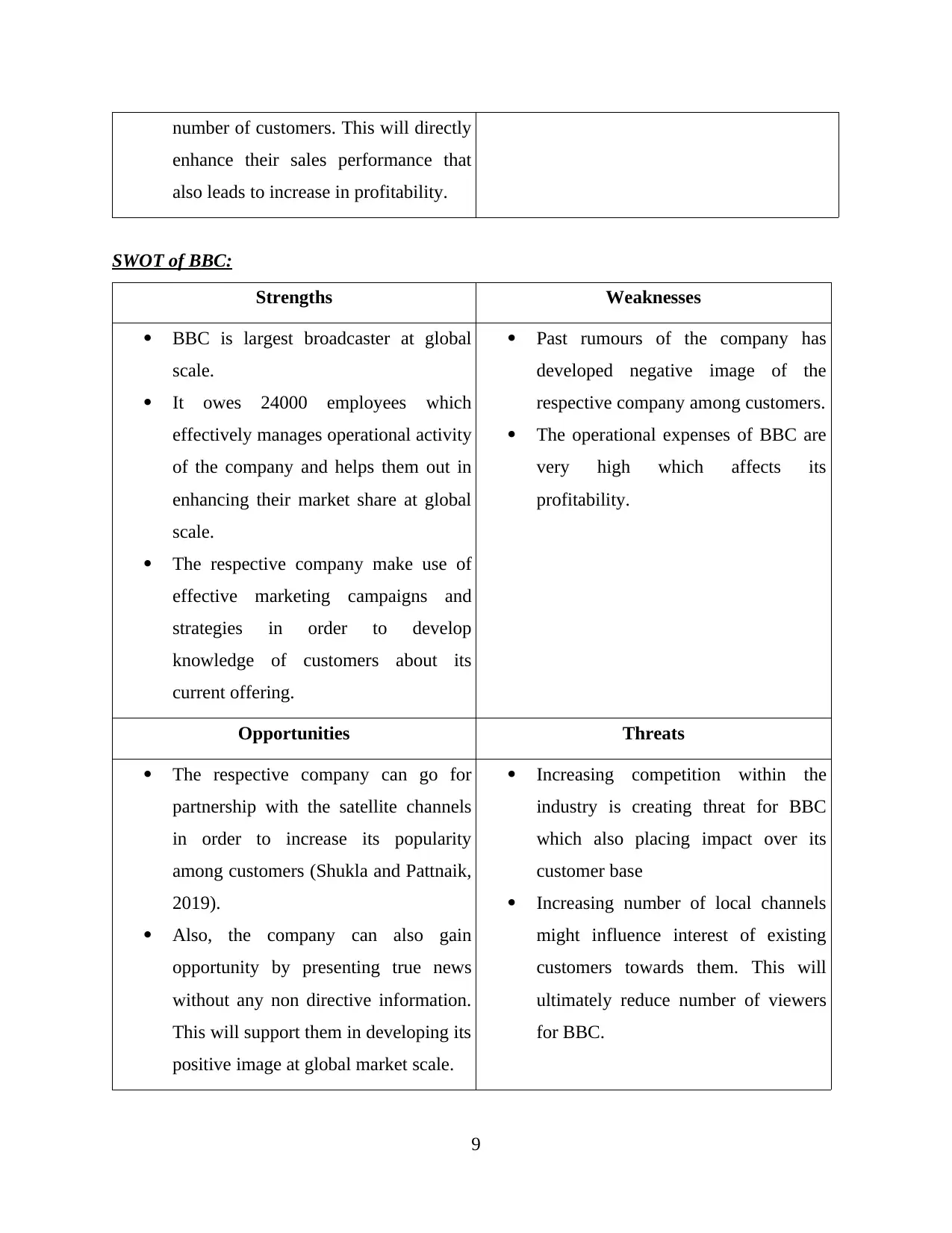
number of customers. This will directly
enhance their sales performance that
also leads to increase in profitability.
SWOT of BBC:
Strengths Weaknesses
BBC is largest broadcaster at global
scale.
It owes 24000 employees which
effectively manages operational activity
of the company and helps them out in
enhancing their market share at global
scale.
The respective company make use of
effective marketing campaigns and
strategies in order to develop
knowledge of customers about its
current offering.
Past rumours of the company has
developed negative image of the
respective company among customers.
The operational expenses of BBC are
very high which affects its
profitability.
Opportunities Threats
The respective company can go for
partnership with the satellite channels
in order to increase its popularity
among customers (Shukla and Pattnaik,
2019).
Also, the company can also gain
opportunity by presenting true news
without any non directive information.
This will support them in developing its
positive image at global market scale.
Increasing competition within the
industry is creating threat for BBC
which also placing impact over its
customer base
Increasing number of local channels
might influence interest of existing
customers towards them. This will
ultimately reduce number of viewers
for BBC.
9
enhance their sales performance that
also leads to increase in profitability.
SWOT of BBC:
Strengths Weaknesses
BBC is largest broadcaster at global
scale.
It owes 24000 employees which
effectively manages operational activity
of the company and helps them out in
enhancing their market share at global
scale.
The respective company make use of
effective marketing campaigns and
strategies in order to develop
knowledge of customers about its
current offering.
Past rumours of the company has
developed negative image of the
respective company among customers.
The operational expenses of BBC are
very high which affects its
profitability.
Opportunities Threats
The respective company can go for
partnership with the satellite channels
in order to increase its popularity
among customers (Shukla and Pattnaik,
2019).
Also, the company can also gain
opportunity by presenting true news
without any non directive information.
This will support them in developing its
positive image at global market scale.
Increasing competition within the
industry is creating threat for BBC
which also placing impact over its
customer base
Increasing number of local channels
might influence interest of existing
customers towards them. This will
ultimately reduce number of viewers
for BBC.
9
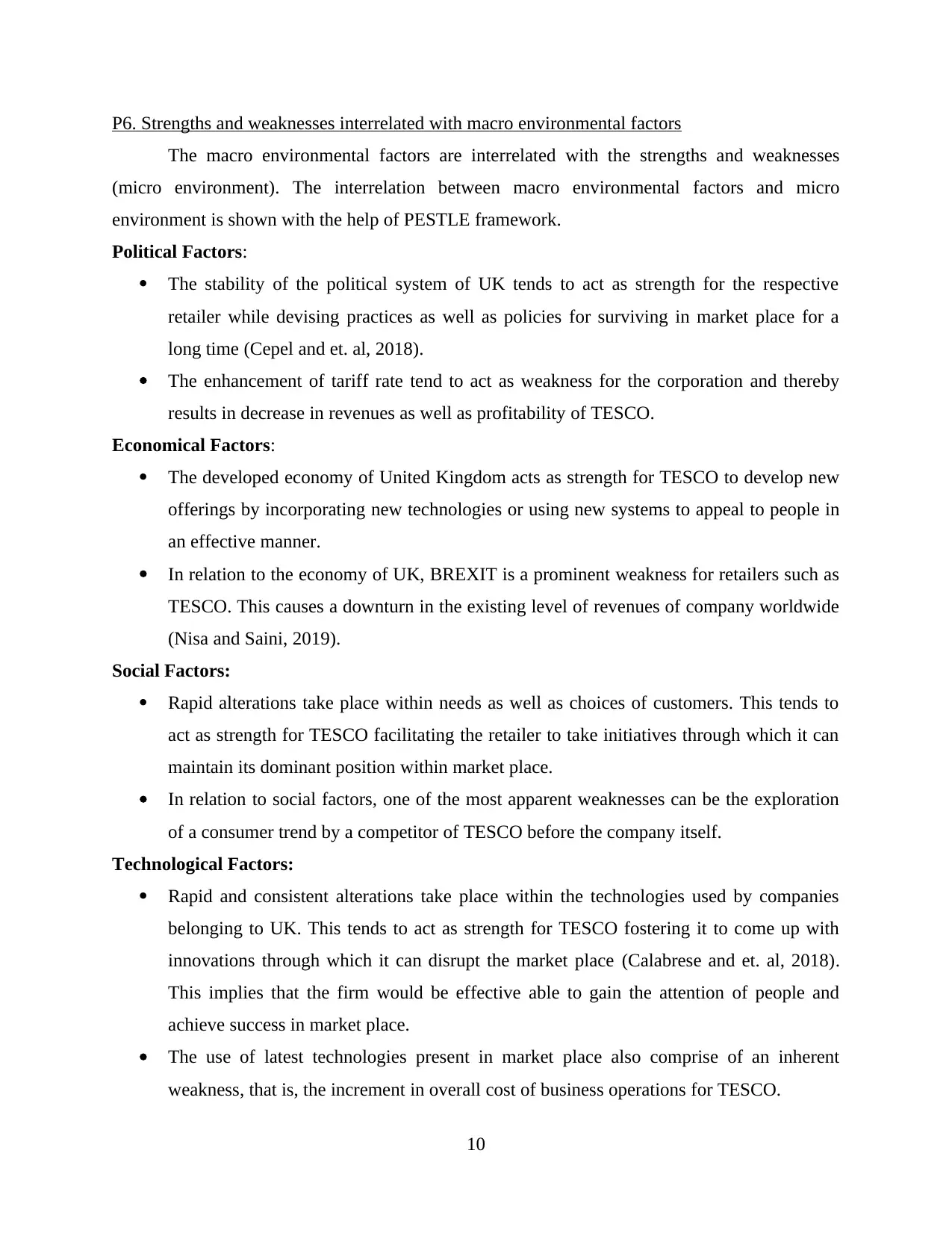
P6. Strengths and weaknesses interrelated with macro environmental factors
The macro environmental factors are interrelated with the strengths and weaknesses
(micro environment). The interrelation between macro environmental factors and micro
environment is shown with the help of PESTLE framework.
Political Factors:
The stability of the political system of UK tends to act as strength for the respective
retailer while devising practices as well as policies for surviving in market place for a
long time (Cepel and et. al, 2018).
The enhancement of tariff rate tend to act as weakness for the corporation and thereby
results in decrease in revenues as well as profitability of TESCO.
Economical Factors:
The developed economy of United Kingdom acts as strength for TESCO to develop new
offerings by incorporating new technologies or using new systems to appeal to people in
an effective manner.
In relation to the economy of UK, BREXIT is a prominent weakness for retailers such as
TESCO. This causes a downturn in the existing level of revenues of company worldwide
(Nisa and Saini, 2019).
Social Factors:
Rapid alterations take place within needs as well as choices of customers. This tends to
act as strength for TESCO facilitating the retailer to take initiatives through which it can
maintain its dominant position within market place.
In relation to social factors, one of the most apparent weaknesses can be the exploration
of a consumer trend by a competitor of TESCO before the company itself.
Technological Factors:
Rapid and consistent alterations take place within the technologies used by companies
belonging to UK. This tends to act as strength for TESCO fostering it to come up with
innovations through which it can disrupt the market place (Calabrese and et. al, 2018).
This implies that the firm would be effective able to gain the attention of people and
achieve success in market place.
The use of latest technologies present in market place also comprise of an inherent
weakness, that is, the increment in overall cost of business operations for TESCO.
10
The macro environmental factors are interrelated with the strengths and weaknesses
(micro environment). The interrelation between macro environmental factors and micro
environment is shown with the help of PESTLE framework.
Political Factors:
The stability of the political system of UK tends to act as strength for the respective
retailer while devising practices as well as policies for surviving in market place for a
long time (Cepel and et. al, 2018).
The enhancement of tariff rate tend to act as weakness for the corporation and thereby
results in decrease in revenues as well as profitability of TESCO.
Economical Factors:
The developed economy of United Kingdom acts as strength for TESCO to develop new
offerings by incorporating new technologies or using new systems to appeal to people in
an effective manner.
In relation to the economy of UK, BREXIT is a prominent weakness for retailers such as
TESCO. This causes a downturn in the existing level of revenues of company worldwide
(Nisa and Saini, 2019).
Social Factors:
Rapid alterations take place within needs as well as choices of customers. This tends to
act as strength for TESCO facilitating the retailer to take initiatives through which it can
maintain its dominant position within market place.
In relation to social factors, one of the most apparent weaknesses can be the exploration
of a consumer trend by a competitor of TESCO before the company itself.
Technological Factors:
Rapid and consistent alterations take place within the technologies used by companies
belonging to UK. This tends to act as strength for TESCO fostering it to come up with
innovations through which it can disrupt the market place (Calabrese and et. al, 2018).
This implies that the firm would be effective able to gain the attention of people and
achieve success in market place.
The use of latest technologies present in market place also comprise of an inherent
weakness, that is, the increment in overall cost of business operations for TESCO.
10
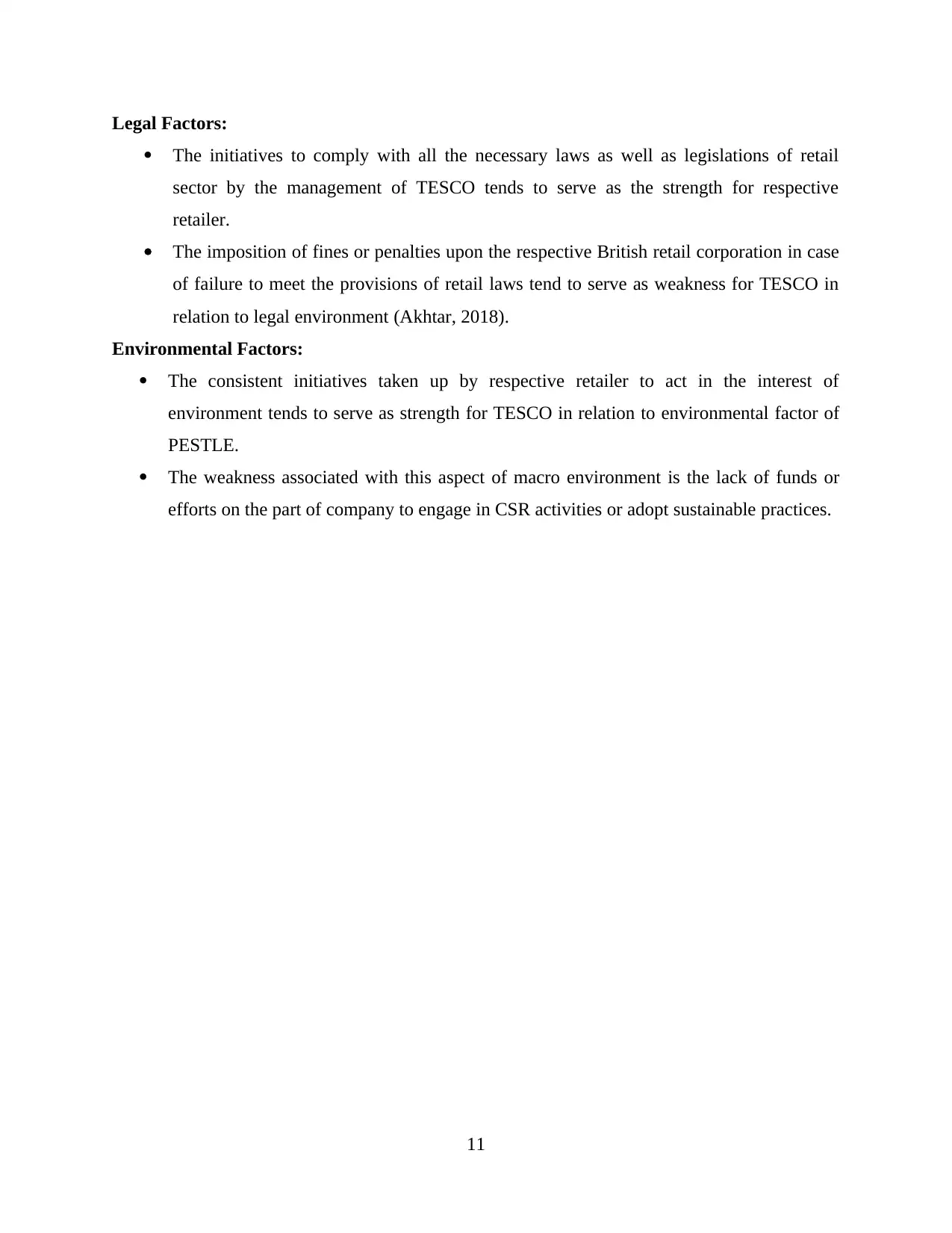
Legal Factors:
The initiatives to comply with all the necessary laws as well as legislations of retail
sector by the management of TESCO tends to serve as the strength for respective
retailer.
The imposition of fines or penalties upon the respective British retail corporation in case
of failure to meet the provisions of retail laws tend to serve as weakness for TESCO in
relation to legal environment (Akhtar, 2018).
Environmental Factors:
The consistent initiatives taken up by respective retailer to act in the interest of
environment tends to serve as strength for TESCO in relation to environmental factor of
PESTLE.
The weakness associated with this aspect of macro environment is the lack of funds or
efforts on the part of company to engage in CSR activities or adopt sustainable practices.
11
The initiatives to comply with all the necessary laws as well as legislations of retail
sector by the management of TESCO tends to serve as the strength for respective
retailer.
The imposition of fines or penalties upon the respective British retail corporation in case
of failure to meet the provisions of retail laws tend to serve as weakness for TESCO in
relation to legal environment (Akhtar, 2018).
Environmental Factors:
The consistent initiatives taken up by respective retailer to act in the interest of
environment tends to serve as strength for TESCO in relation to environmental factor of
PESTLE.
The weakness associated with this aspect of macro environment is the lack of funds or
efforts on the part of company to engage in CSR activities or adopt sustainable practices.
11
Paraphrase This Document
Need a fresh take? Get an instant paraphrase of this document with our AI Paraphraser
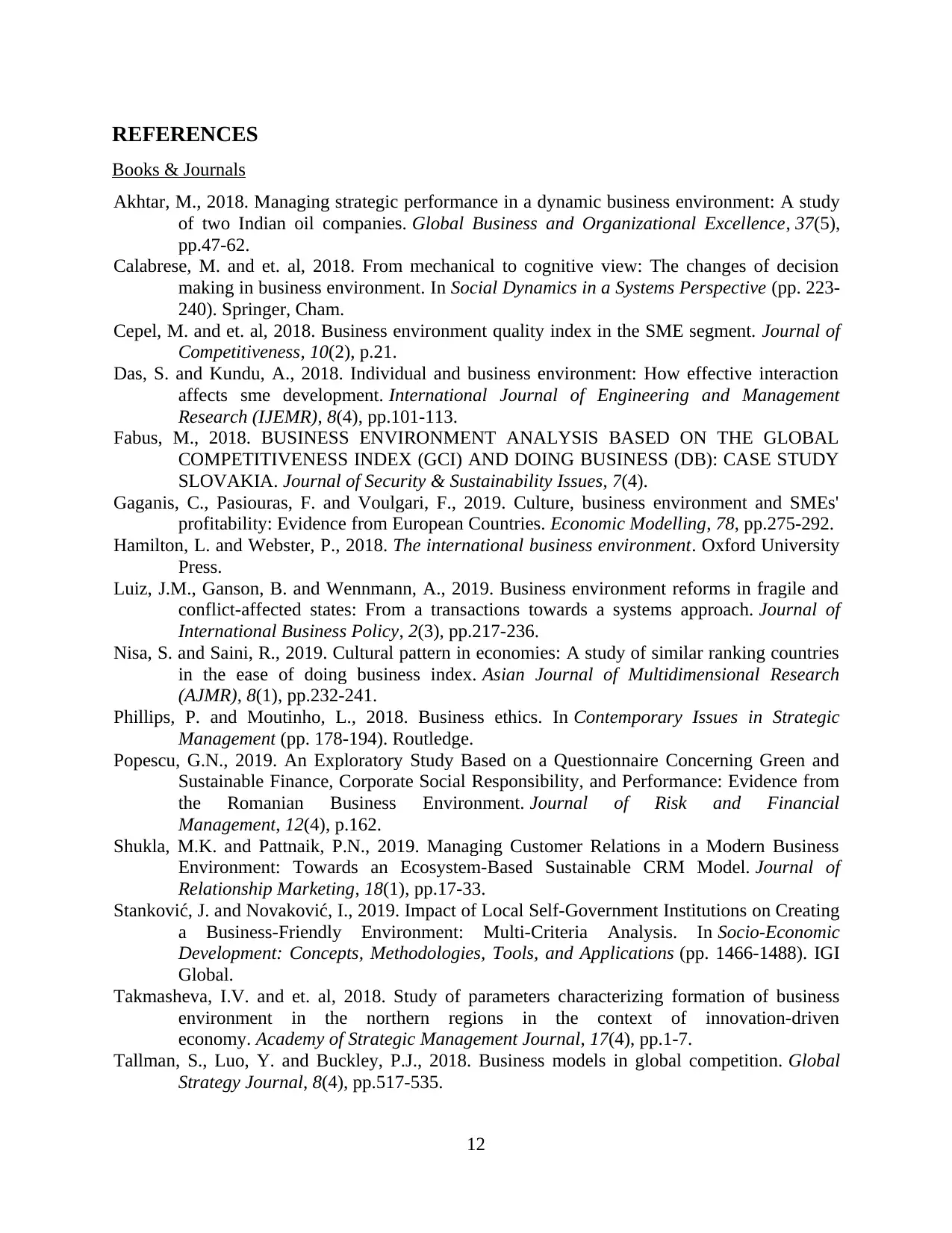
REFERENCES
Books & Journals
Akhtar, M., 2018. Managing strategic performance in a dynamic business environment: A study
of two Indian oil companies. Global Business and Organizational Excellence, 37(5),
pp.47-62.
Calabrese, M. and et. al, 2018. From mechanical to cognitive view: The changes of decision
making in business environment. In Social Dynamics in a Systems Perspective (pp. 223-
240). Springer, Cham.
Cepel, M. and et. al, 2018. Business environment quality index in the SME segment. Journal of
Competitiveness, 10(2), p.21.
Das, S. and Kundu, A., 2018. Individual and business environment: How effective interaction
affects sme development. International Journal of Engineering and Management
Research (IJEMR), 8(4), pp.101-113.
Fabus, M., 2018. BUSINESS ENVIRONMENT ANALYSIS BASED ON THE GLOBAL
COMPETITIVENESS INDEX (GCI) AND DOING BUSINESS (DB): CASE STUDY
SLOVAKIA. Journal of Security & Sustainability Issues, 7(4).
Gaganis, C., Pasiouras, F. and Voulgari, F., 2019. Culture, business environment and SMEs'
profitability: Evidence from European Countries. Economic Modelling, 78, pp.275-292.
Hamilton, L. and Webster, P., 2018. The international business environment. Oxford University
Press.
Luiz, J.M., Ganson, B. and Wennmann, A., 2019. Business environment reforms in fragile and
conflict-affected states: From a transactions towards a systems approach. Journal of
International Business Policy, 2(3), pp.217-236.
Nisa, S. and Saini, R., 2019. Cultural pattern in economies: A study of similar ranking countries
in the ease of doing business index. Asian Journal of Multidimensional Research
(AJMR), 8(1), pp.232-241.
Phillips, P. and Moutinho, L., 2018. Business ethics. In Contemporary Issues in Strategic
Management (pp. 178-194). Routledge.
Popescu, G.N., 2019. An Exploratory Study Based on a Questionnaire Concerning Green and
Sustainable Finance, Corporate Social Responsibility, and Performance: Evidence from
the Romanian Business Environment. Journal of Risk and Financial
Management, 12(4), p.162.
Shukla, M.K. and Pattnaik, P.N., 2019. Managing Customer Relations in a Modern Business
Environment: Towards an Ecosystem-Based Sustainable CRM Model. Journal of
Relationship Marketing, 18(1), pp.17-33.
Stanković, J. and Novaković, I., 2019. Impact of Local Self-Government Institutions on Creating
a Business-Friendly Environment: Multi-Criteria Analysis. In Socio-Economic
Development: Concepts, Methodologies, Tools, and Applications (pp. 1466-1488). IGI
Global.
Takmashеva, I.V. and et. al, 2018. Study of parameters characterizing formation of business
environment in the northern regions in the context of innovation-driven
economy. Academy of Strategic Management Journal, 17(4), pp.1-7.
Tallman, S., Luo, Y. and Buckley, P.J., 2018. Business models in global competition. Global
Strategy Journal, 8(4), pp.517-535.
12
Books & Journals
Akhtar, M., 2018. Managing strategic performance in a dynamic business environment: A study
of two Indian oil companies. Global Business and Organizational Excellence, 37(5),
pp.47-62.
Calabrese, M. and et. al, 2018. From mechanical to cognitive view: The changes of decision
making in business environment. In Social Dynamics in a Systems Perspective (pp. 223-
240). Springer, Cham.
Cepel, M. and et. al, 2018. Business environment quality index in the SME segment. Journal of
Competitiveness, 10(2), p.21.
Das, S. and Kundu, A., 2018. Individual and business environment: How effective interaction
affects sme development. International Journal of Engineering and Management
Research (IJEMR), 8(4), pp.101-113.
Fabus, M., 2018. BUSINESS ENVIRONMENT ANALYSIS BASED ON THE GLOBAL
COMPETITIVENESS INDEX (GCI) AND DOING BUSINESS (DB): CASE STUDY
SLOVAKIA. Journal of Security & Sustainability Issues, 7(4).
Gaganis, C., Pasiouras, F. and Voulgari, F., 2019. Culture, business environment and SMEs'
profitability: Evidence from European Countries. Economic Modelling, 78, pp.275-292.
Hamilton, L. and Webster, P., 2018. The international business environment. Oxford University
Press.
Luiz, J.M., Ganson, B. and Wennmann, A., 2019. Business environment reforms in fragile and
conflict-affected states: From a transactions towards a systems approach. Journal of
International Business Policy, 2(3), pp.217-236.
Nisa, S. and Saini, R., 2019. Cultural pattern in economies: A study of similar ranking countries
in the ease of doing business index. Asian Journal of Multidimensional Research
(AJMR), 8(1), pp.232-241.
Phillips, P. and Moutinho, L., 2018. Business ethics. In Contemporary Issues in Strategic
Management (pp. 178-194). Routledge.
Popescu, G.N., 2019. An Exploratory Study Based on a Questionnaire Concerning Green and
Sustainable Finance, Corporate Social Responsibility, and Performance: Evidence from
the Romanian Business Environment. Journal of Risk and Financial
Management, 12(4), p.162.
Shukla, M.K. and Pattnaik, P.N., 2019. Managing Customer Relations in a Modern Business
Environment: Towards an Ecosystem-Based Sustainable CRM Model. Journal of
Relationship Marketing, 18(1), pp.17-33.
Stanković, J. and Novaković, I., 2019. Impact of Local Self-Government Institutions on Creating
a Business-Friendly Environment: Multi-Criteria Analysis. In Socio-Economic
Development: Concepts, Methodologies, Tools, and Applications (pp. 1466-1488). IGI
Global.
Takmashеva, I.V. and et. al, 2018. Study of parameters characterizing formation of business
environment in the northern regions in the context of innovation-driven
economy. Academy of Strategic Management Journal, 17(4), pp.1-7.
Tallman, S., Luo, Y. and Buckley, P.J., 2018. Business models in global competition. Global
Strategy Journal, 8(4), pp.517-535.
12
1 out of 14
Related Documents
Your All-in-One AI-Powered Toolkit for Academic Success.
+13062052269
info@desklib.com
Available 24*7 on WhatsApp / Email
![[object Object]](/_next/static/media/star-bottom.7253800d.svg)
Unlock your academic potential
© 2024 | Zucol Services PVT LTD | All rights reserved.





